The Great White Way Revisited
For those that might be unaware, I love the color pie. It is the foundation of Magic both in flavor and mechanics, and gives the game a psychological underpinning that creates a unique identity. Back in 2003, I wrote a series of articles where I examined each of the five colors and delved into its philosophy. Well, in the last twelve years, I have had a lot of time to fine-tune how I think about the colors and their relationship with each other; so I decided it was time to revisit those articles and dig a little deeper. (One quick note: of all the colors, white was the one I think I hit best twelve years ago, but white came first in our theme weeks, so white it is.)
In those articles I asked six questions. I am going to ask the same questions, but explore a few facets that I didn't last time around. As a reminder, here are the six questions:
- What does the color desire? What is its end goal?
- What means does the color use to achieve these ends?
- What does the color care about? What does the color represent?
- What does the color despise? What negatively drives the color?
- Why does the color like its allies and hate its enemies?
- What is the color's greatest strength and biggest weakness?
At the end, as I did last time, I will give some pop culture examples of characters that are primarily white.
Let's get to it.
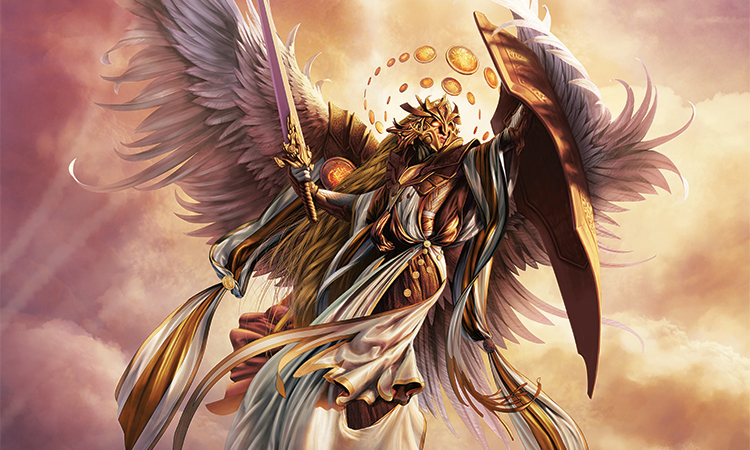
Patron of the Valiant | Art by Steve Argyle
What does the color desire? What is its end goal?
White wants peace.
White looks around and sees a world of suffering. There are so many individuals that struggle day to day, but the world has the resources to address this suffering. There is enough for everyone to have what they need (as opposed to what they want). Suffering is a by-product of individuals not prioritizing the good of the group.
White wants to create a world where there is no unnecessary suffering, a world where life is as good as it can be for each individual. The key to making this happen is teaching individuals the importance of taking actions which benefit the group as a whole, even if those actions might not benefit them personally.
The problem with this plan is it can only succeed if everyone is working toward the same unified goal. As soon as some individuals prioritize other things, like say their own desires, the plan falls apart. This means that white has to work extra hard to get the group to understand the power it holds and to keep the focus on the bigger picture.
White does want as many as possible to understand its motives and share them. But white realizes that in order to accomplish its larger goal, some individuals will have to be lead down the path rather than venture there of their own accord.

Grasp of the Hieromancer | Art by Igor Kieryluk
What means does the color use to achieve these ends?
How do you get a large number of individuals to all follow the same path? By creating rigid structure. There are simply too many temptations to leave the larger task in the hands of individual choice. As such, white has embraced rules and laws. If the system spells out what each individual can and cannot do, individuals do what they are supposed to.
This structure breaks into two pieces: moral laws and civil laws. The moral laws are defining the concepts of right and wrong. Certain actions are moral and thus need to be encouraged, while other actions are immoral and need to be discouraged. The importance of moral laws is making individuals understand that there is a right and wrong way to think. This frames the larger picture—the need to prioritize the group. Inherent in moral laws is the implication that there is a long-term penalty for failure to abide by them.
Civil laws clamp down on unwanted actions. Do thing X and there will be an immediate consequence, most often in the form of a loss of resources (usually money) and/or freedom. Illegal actions will be punished as soon as they are noticed. Civil laws are usually enforced by the government through police or military.
The moral laws control how people think and the civil laws control how they act. Together, these two forms of structure create a framework that helps ensure individuals are working for the benefit of the group.
I should note that white's influence can also be a bit more subtle, as it introduces the idea of a conscience. The concepts of right and wrong can be introduced in many ways from personal codes to ideals like honor or chivalry. White also makes use of things like guilt to help keep individuals in line.
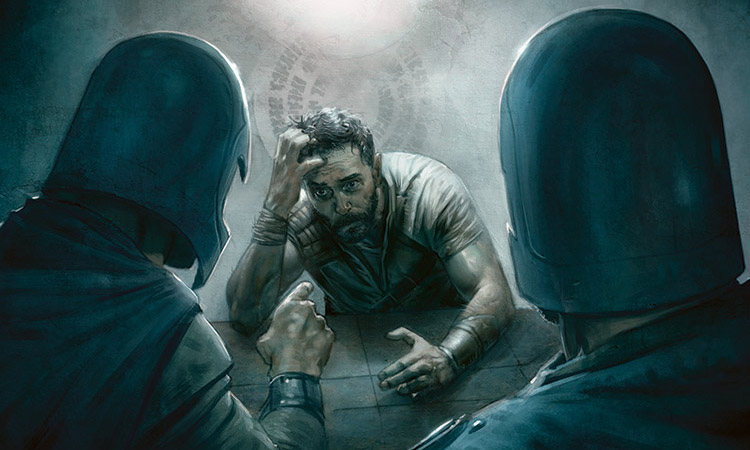
Arrest | Art by Greg Staples
What does the color care about? What does the color represent?
Here are a number of things white cares about along with why:
Religion—While there are different ways to teach moral law, religion has proven to be the most effective.
Military—White believes that strength comes from many individuals banding together, making a whole that is much more powerful than the sum of its parts. The military is a perfect example where individual soldiers come together to make a powerful army. Also, this plays into white's reliance on the combined strength of a lot of little things, the strength of numbers.
Law—Civil structure is based upon the creation of rules by the governing body. The law is a powerful tool to help control the actions of individuals in a society.
Court System—Part of creating laws is ensuring that they are properly applied.
Politics—In order for laws to be potent and do their necessary work, you have to make sure you are the ones in charge of creating, interpreting, and enforcing them. Politics is just an elaborate structure to ensure that this is so.
Government—Something that allows white to oversee the military, laws, court system, and politics.
Community—Looking out for the group means the group will look out for your causes.
Honor—According to white's definition of "honor," it's another twist on moral laws. It is a system that prioritizes individuals acting in the interest of the group.
Chivalry—Yet another twist on moral laws.
Defense—White's entire philosophy is about the welfare of the group. This extends to conflict, where white prioritizes no one getting hurt. In addition, defense plays into white's strength of using structure as a weapon.
Self-sacrifice—If you believe that decisions need to be made for the good of the group over the good of the individual, sometimes the right move is to sacrifice yourself for the greater good.
Cooperation—The power of the group is its ability to work together.
Light—White believes that secrets are dangerous, in that they allow people to act as if they are working toward the good of the group when in reality they are not. Light metaphorically represents white's desire to bring things out into the open. It also plays into the imagery that white likes playing up, of the idea of good vs. evil. Remember that this conflict is how white likes to frame it, as black doesn't believe in the concepts of good or evil or even the concept of morality itself.
Purity—White sees its ideals as absolute and shies away from the idea that there are gray areas. White, interestingly enough, sees things in black and white.
Charity—An important part of making sure every individual is looked after is having those with more help those with less.
Strategy—Structure can also be applied to warfare and other conflicts. Part of making your army successful is making sure each individual is contributing to the larger goal.
Organization—Structure also helps you keep track of what resources you have.
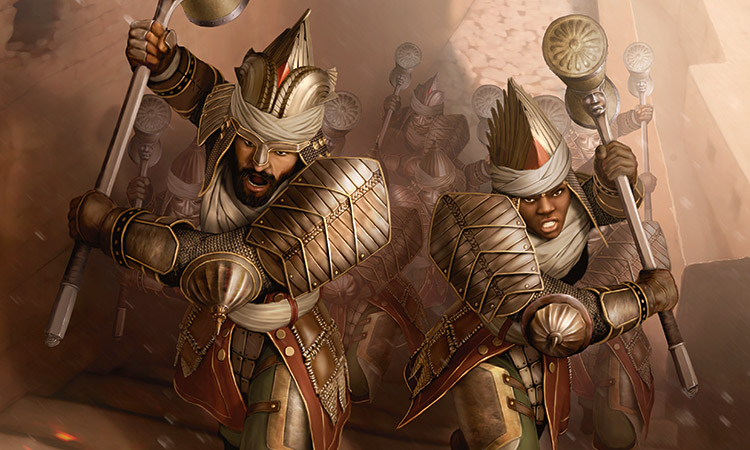
Heavy Infantry | Art by David Gaillet
What does the color despise? What negatively drives the color?
White abhors anything which gets in the way of protecting the larger group. The two biggest issues are selfishness and recklessness. The first hurts others because it motivates an individual to not care that their actions are resulting in the harm of others. The second is a problem because it keeps an individual from being aware that they are hurting others. These two issues fly in the face of the two types of laws white uses. Selfishness undermines moral law while recklessness undermines civil law. Obviously this brings white into conflict with black and red, as black is primarily responsible for the first while red is primarily responsible for the second. More on this in a moment.
White is so obsessed with maintaining its structure that it can dwell on the tiny details. This can cause white to get agitated over what, on the surface, might appear to be a minor issue. White believes that all its rules must be followed, so it will at times treat minor infractions with the same vigor as major ones. White can also take individual losses very hard because it truly does care about the welfare of everyone.

Iona, Shield of Emeria | Art by Jason Chan
Why does the color like its allies and hate its enemies?
White looks at blue and sees a color that understands the value of carefully thinking things through. Blue, like white, is very detail oriented and sees the power in rules. White and blue share red as an enemy and are both concerned about the danger of impulsivity and emotion. Where white is a little concerned is that blue, as an ally of black, values the contributions of individuals higher than white is comfortable with. White wishes blue would focus more on perfecting society as a whole and less on perfecting individuals.
White looks at green and sees a color that shares its importance of community. Both colors find understanding the role an individual plays in the context of the world around them to be key. White and green share black as an enemy, and both dislike how black's selfish motives actively try to disrupt the harmony of those around it. White's concern with green comes from its bonding with red over embracing its wild side. Green seems okay with losing control, something that white knows only leads to trouble.
White looks at black and hates its focus on the importance of the individual. Black is selfish, immoral, and cruel. Black not only allows others to suffer but will actively be the one causing the suffering. Black actually enjoys inflicting pain. Black seems to go out of its way to break every moral code white has identified. If black had its way, individuals would only look out for themselves, and a vast majority of them would suffer. As a rule, white believes in nonviolence, but black is such a danger that white makes an exception. Black is a cancer that, if not excised, will kill society as a whole.
White looks at red and is afraid of the carelessness it enables. Red is impulsive, following its emotions, and thus is unpredictable and reckless. Red has no regard for laws and seems to break them without a second thought. Red is less sadistic than black, but no less dangerous. By undermining white's laws, red is inviting anarchy-creating chaos with just as much potential to cause harm to individuals. Red needs to be restrained and locked up before it can do any more damage.
The tie between the white/black conflict of the group versus the individual, and the red/white conflict of chaos versus order, deals with white's preoccupation with minimizing any disruption into its greater plan. In each case, white sees its enemy as a source of danger and feels it has to proactively stop it before individuals come to harm.
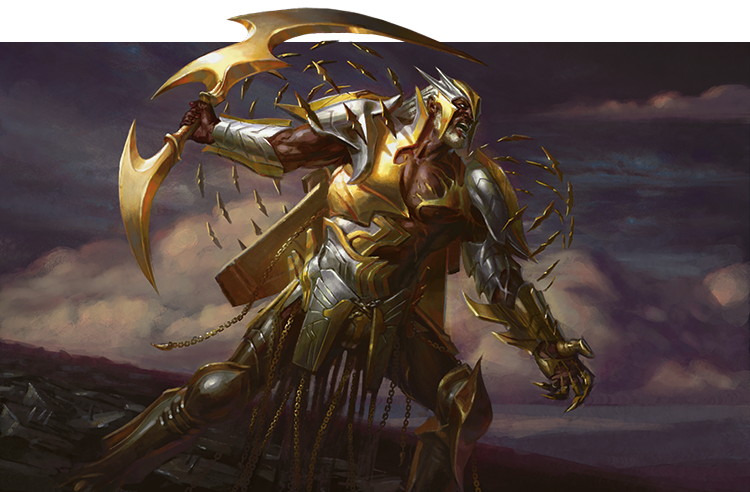
Mirran Crusader | Art by Eric Deschamps
What is the color's greatest strength and biggest weakness?
White's greatest strength is its organization. White is detail oriented and always has an answer to every problem. White has built up a complex infrastructure and is very efficient at using that infrastructure, be it laws, politics, or religion to its benefit. White's division of power, spreading evenly among all its supporters, makes defeating it difficult because no one piece is, unto itself, more important than any other piece. Finally, white has learned how to make small pieces interact in a way where their power is far stronger than the sum of their parts.
White's greatest weakness comes from its reliance on structure. White has no flexibility. It can only adapt to the things it predicted, and has great trouble when something new comes along. This inflexibility makes white slow to adapt so white can often fall behind when an environment changes. White also, at times, has trouble distinguishing how important any one facet is, as it likes to treat everything equally.
Another way to think of it is: white's greatest strength is its effective use of the group, white's greatest weakness is its disregard for the power of the individual.
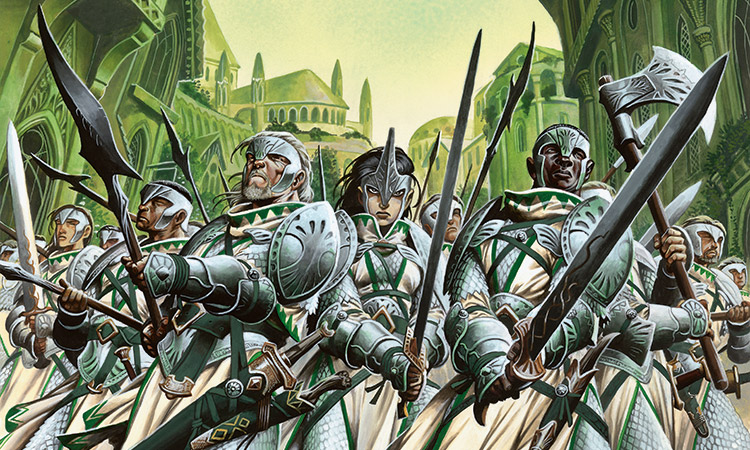
Conclave Phalanx | Art by Wayne Reynolds
White-aligned Characters in Pop Culture
As it's twelve years later, I thought I'd pick some more recent examples.
Barry Allen (The Flash)
Barry gets hit by a bolt of lightning and some chemicals, and gains super speed. What does he do with this power? Does he abuse it or find ways for personal gain? No, he works to protect Central City against those that want to harm its citizens.
Brienne of Tarth (Game of Thrones)
For starters, Brienne is a knight. She pledges her services for the welfare of others and only for people who she feels are inherently good. Her word is her bond and she is always actively trying to uphold a high standard of morals. In addition, she is honest, honorable, and fair.
Tyresse (Walking Dead)
There are few mono-white characters in the zombie apocalypse of The Walking Dead, but Tyresse is one of them. He dislikes killing, even zombies, and is always there to try and protect others. In particular, he seems focused on protecting those who are unable to protect themselves.
James Gordon (Gotham)
James Gordon is an honest cop on a corrupted police force. He never backs down from doing what he believes is the right thing even when it's clear there will be a price to pay for doing it.
Alexander Pierce (Captain America: The Winter Soldier)
SPOILERS (IF YOU HAVEN'T SEEN THE MOVIE, STOP READING)
Alexander is a good example of a mono-white villain. He truly believes that what he is doing will make the world a better place even though it means the killing of millions.
Finally, it's a repeat from last time but one of my favorite color pie quintets, the Simpsons. (The family of five has one family member of each color.)
Marge Simpson
Marge is the moral center of the Simpsons and is the one always looking out for the welfare of the family as a whole. She relies on structure, is protective and is the most self-sacrificial.
Everything's All White
One of my favorite parts of my job is interacting with the color pie, so it's always fun for me when I get to write about it in my column. As such, I'm eager to know what you thought of today's column. You can write to me through my email or any of my social media (Twitter, Tumblr, Google+, and Instagram).
Join me next week, when I do some more revisiting, this time with Vorthos and Mel(vin).
"Drive to Work #242—Avacyn Restored, Part 2"
This is part two of my four-part series on the design of Avacyn Restored.
"Drive to Work #243—Avacyn Restored Part 3"
This is part three of my four-part series on the design of Avacyn Restored.
- Episode 243 Avacyn Restored, Part 3 (15.4 MB)
- Episode 242 Avacyn Restored, Part 2 (14.8 MB)
- Episode 241 Avacyn Restored, Part 1 (14.6 MB)
- Episode 240 Pro Tour with Melissa DeTora (14.0 MB)
- Episode 239 Starting in R&D (15.0 MB)

